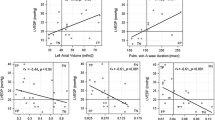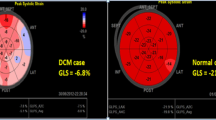Abstract
Guidelines for diagnosis and grading of diastolic dysfunction (DD) in children have not been established. The applicability of adult parameters of DD to children has been questioned by recent studies. Although normal diastolic parameters in children have been published, the data to support application of these indices for the non-invasive diagnosis of DD and quantifying its degree are still being developed. Restrictive cardiomyopathy (RCM) is the only recognized disease entity in children that presents with isolated, irreversible DD as the predominant finding. The aim of this study was to investigate the applicability of current diastolic indices used for assessment of diastolic function in adults as reliable indicators of DD in children with established RCM. Retrospective review of institutional clinical database for the period of 2002–2010 was performed to identify patients with RCM who had had a comprehensive echocardiographic assessment of diastolic function. The following parameters were obtained from apical four chamber view: mitral valve (MV) inflow Doppler early filling velocity (E), late filling velocity (A), deceleration time (DT), color M-mode flow propagation from MV to apex (Vp), Doppler tissue imaging derived early diastolic velocity E′ and late diastolic velocity A′ at the LV lateral wall at MV annulus, RV at the tricuspid valve annulus, septum, and LA area. All parameters were compared to age and gender matched controls using student t test. : LA area/BSA was significantly larger in RCM group than the control group, median 22.8 cm2/m2 (range 16.9–28.6) versus 10.3 cm2/m2 (range 8.3–12.3), p value <0.001. MV inflow E and A were lower, and DT was shorter in the RCM group (p = 0.04, 0.02, and 0.005, respectively). A wave was absent in 3 of 9 patients in the RCM group. Ratio of E to A (E/A) was not different between the two groups. E′ was significantly lower at all three sites in RCM group; however, there was some overlap between the two groups. E/septal E′ ratio was statistically significantly higher in RCM group. A′ was absent either at lateral wall or at septum in five patients. 7 of 9 patients in RCM group had L′ wave (at lateral wall or septum) defined as negative deflection during diastasis. Vp was higher in RCM group than in the control group 81.4 ± 44.5 versus 52.9 ± 10.9, p value <0.01. Combination of increased left atrial size, septal E/E′, and lack of A wave and presence of mid-diastolic L′-wave are the noted abnormalities in this group. Individual cut-offs for Doppler indices have very poor sensitivity in identifying restrictive physiology. These findings suggest that poor LV compliance is the hallmark of restrictive cardiomyopathy in children even in the presence of normal early relaxation and ventricular filling. These findings support the need for development of guidelines for diagnosis and physiologic grading of diastolic dysfunction in children.



Similar content being viewed by others
References
Border WL, Michelfelder EC, Glascock BJ, Witt SA, Spicer RL, Beekman RH 3rd et al (2003) Color M-mode and doppler tissue evaluation of diastolic function in children: simultaneous correlation with invasive indices. J Am Soc Echocardiogr 16(9):988–994
Brun P, Tribouilloy C, Duval AM, Iserin L, Meguira A, Pelle G et al (1992) Left ventricular flow propagation during early filling is related to wall relaxation: A color M-mode doppler analysis. J Am Coll Cardiol 20(2):420–432
Dragulescu A, Mertens L, Friedberg MK (2013) Interpretation of left ventricular diastolic dysfunction in children with cardiomyopathy by echocardiography: problems and limitations. Circ Cardiovasc Imaging 6(2):254–261
Eidem BW, McMahon CJ, Cohen RR, Wu J, Finkelshteyn I, Kovalchin JP et al (2004) Impact of cardiac growth on doppler tissue imaging velocities: a study in healthy children. J Am Soc Echocardiogr 17(3):212–221
Gewillig M, Mertens L, Moerman P, Dumoulin M (1996) Idiopathic restrictive cardiomyopathy in childhood. A diastolic disorder characterized by delayed relaxation. Eur Heart J 17(9):1413–1420
Leonardi B, Margossian R, Colan SD, Powell AJ (2008) Relationship of magnetic resonance imaging estimation of myocardial iron to left ventricular systolic and diastolic function in thalassemia. JACC Cardiovasc Imaging 1(5):572–578
Lipshultz S, Sleeper L, Sleeper L, Towbin J, Lowe A, Orav E, Cox G et al (2003) The incidence of pediatric cardiomyopathy in two regions of the united states. N Engl J Med 348(17):1647–1655
Nagueh SF, Appleton CP, Gillebert TC, Marino PN, Oh JK, Smiseth OA et al (2009) Recommendations for the evaluation of left ventricular diastolic function by echocardiography. J Am Soc Echocardiogr 22(2):107–133
Nishihara K, Mikami T, Takatsuji H, Onozuka H, Saito N, Yamada S et al (2000) Usefulness of early diastolic flow propagation velocity measured by color M-mode doppler technique for the assessment of left ventricular diastolic function in patients with hypertrophic cardiomyopathy. J Am Soc Echocardiogr 13(9):801–808
Nugent AW, Daubeney PE, Chondros P, Carlin JB, Cheung M, Wilkinson LC et al (2003) The epidemiology of childhood cardiomyopathy in Australia. N Engl J Med 348(17):1639–1646
Owan TE, Hodge DO, Herges RM, Jacobsen SJ, Roger VL, Redfield MM (2006) Trends in prevalence and outcome of heart failure with preserved ejection fraction. N Engl J Med 355(3):251–259
Rajagopalan N, Garcia MJ, Rodriguez L, Murray RD, Apperson-Hansen C, Stugaard M et al (2001) Comparison of new doppler echocardiographic methods to differentiate constrictive pericardial heart disease and restrictive cardiomyopathy. Am J Cardiol 87(1):86–94
Rivenes SM, Kearney DL, Smith EO, Towbin JA, Denfield SW (2000) Sudden death and cardiovascular collapse in children with restrictive cardiomyopathy. Circulation 102(8):876–882
Swaminathan S, Ferrer PL, Wolff GS, Gomez-Marin O, Rusconi PG (2003) Usefulness of tissue doppler echocardiography for evaluating ventricular function in children without heart disease. Am J Cardiol 91(5):570–574
Taggart NW, Cetta F, O’Leary PW, Seward JB, Eidem BW (2010) Left atrial volume in children without heart disease and in those with ventricular septal defect or patent ductus arteriosus or hypertrophic cardiomyopathy. Am J Cardiol 106(10):1500–1504
Takatsuji H, Mikami T, Urasawa K, Teranishi J, Onozuka H, Takagi C et al (1996) A new approach for evaluation of left ventricular diastolic function: Spatial and temporal analysis of left ventricular filling flow propagation by color M-mode doppler echocardiography. J Am Coll Cardiol 27(2):365–371
Author information
Authors and Affiliations
Corresponding author
Rights and permissions
About this article
Cite this article
Sasaki, N., Garcia, M., Ko, H.H. et al. Applicability of Published Guidelines for Assessment of Left Ventricular Diastolic Function in Adults to Children with Restrictive Cardiomyopathy: An Observational Study. Pediatr Cardiol 36, 386–392 (2015). https://doi.org/10.1007/s00246-014-1018-z
Received:
Accepted:
Published:
Issue Date:
DOI: https://doi.org/10.1007/s00246-014-1018-z




